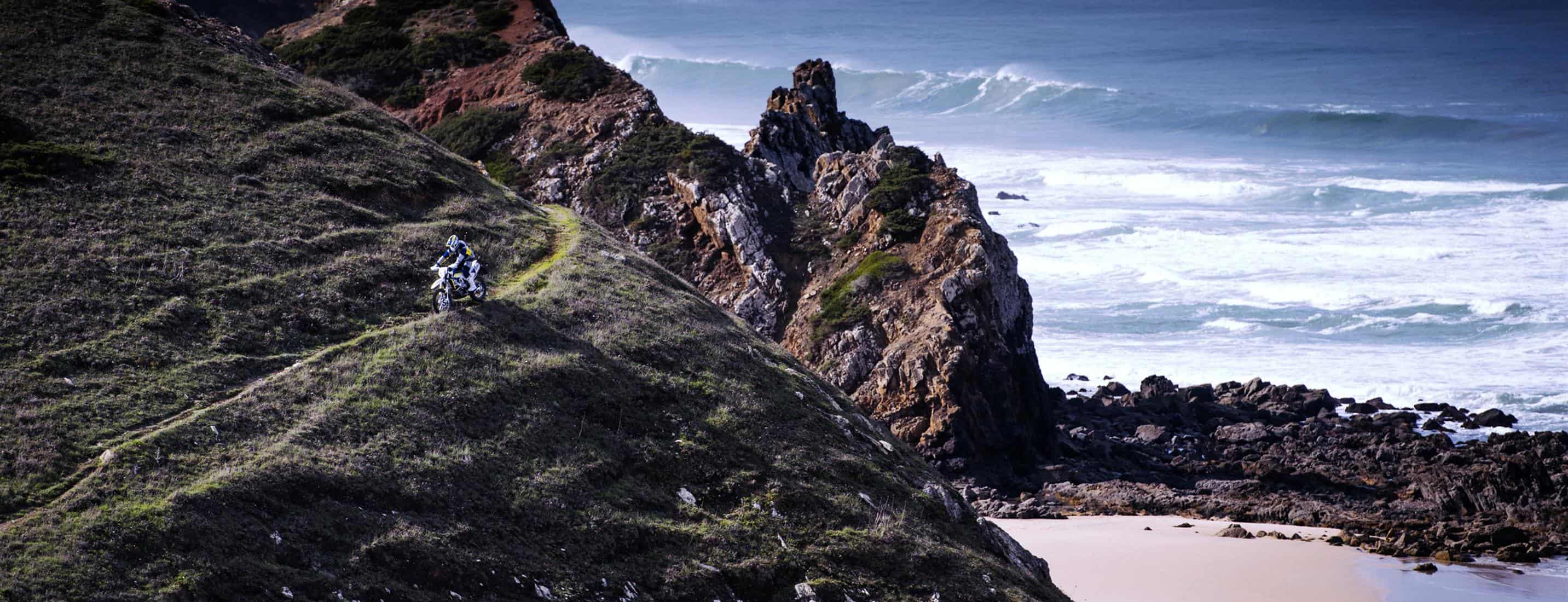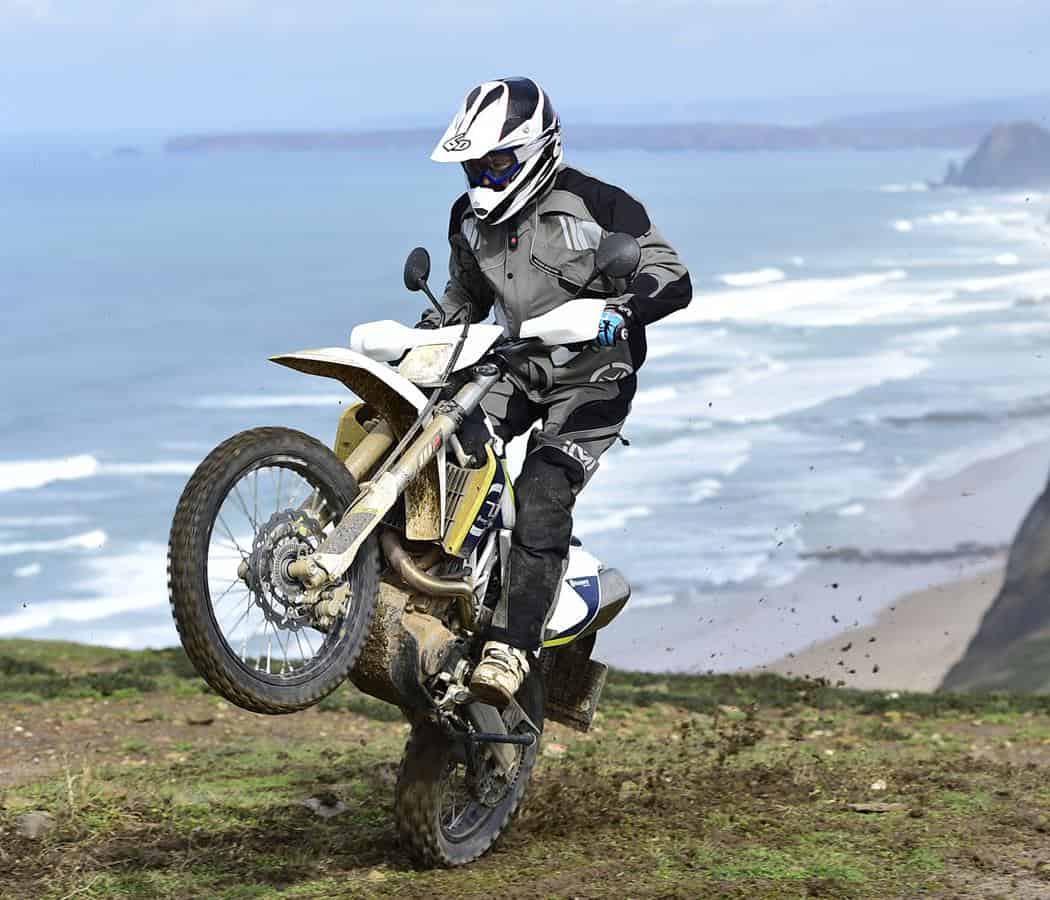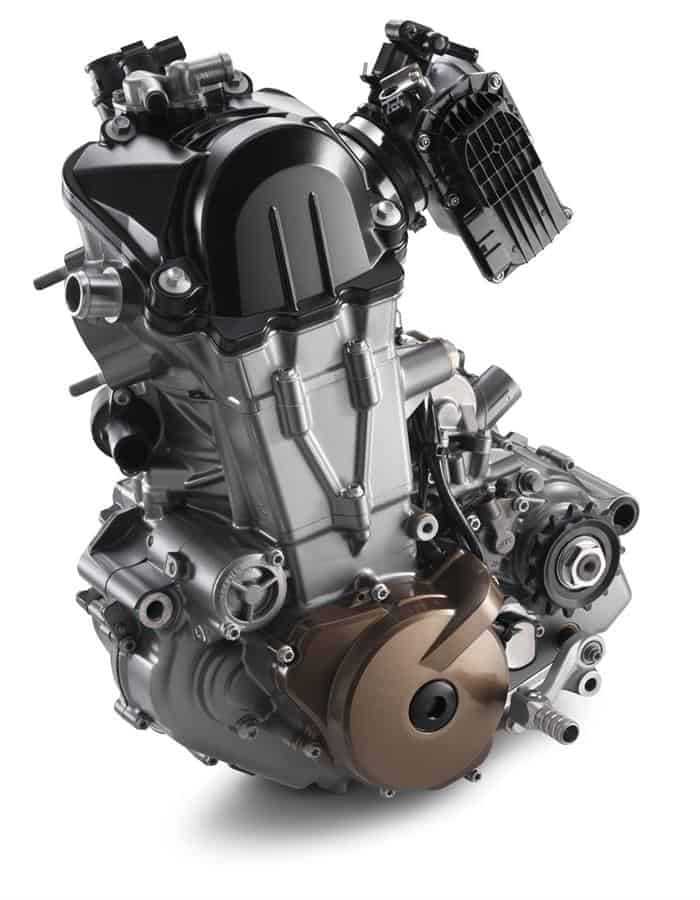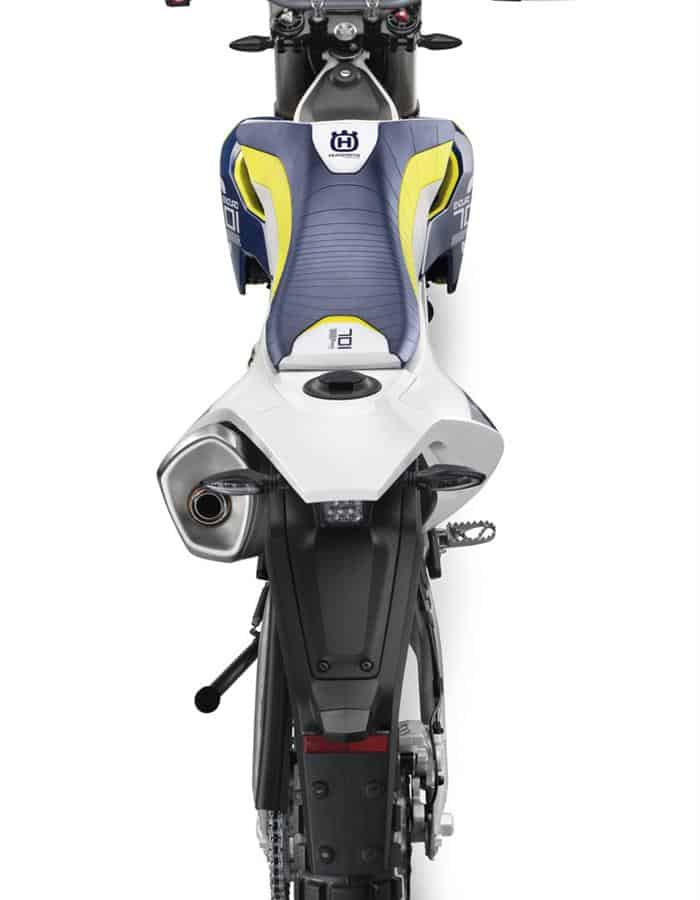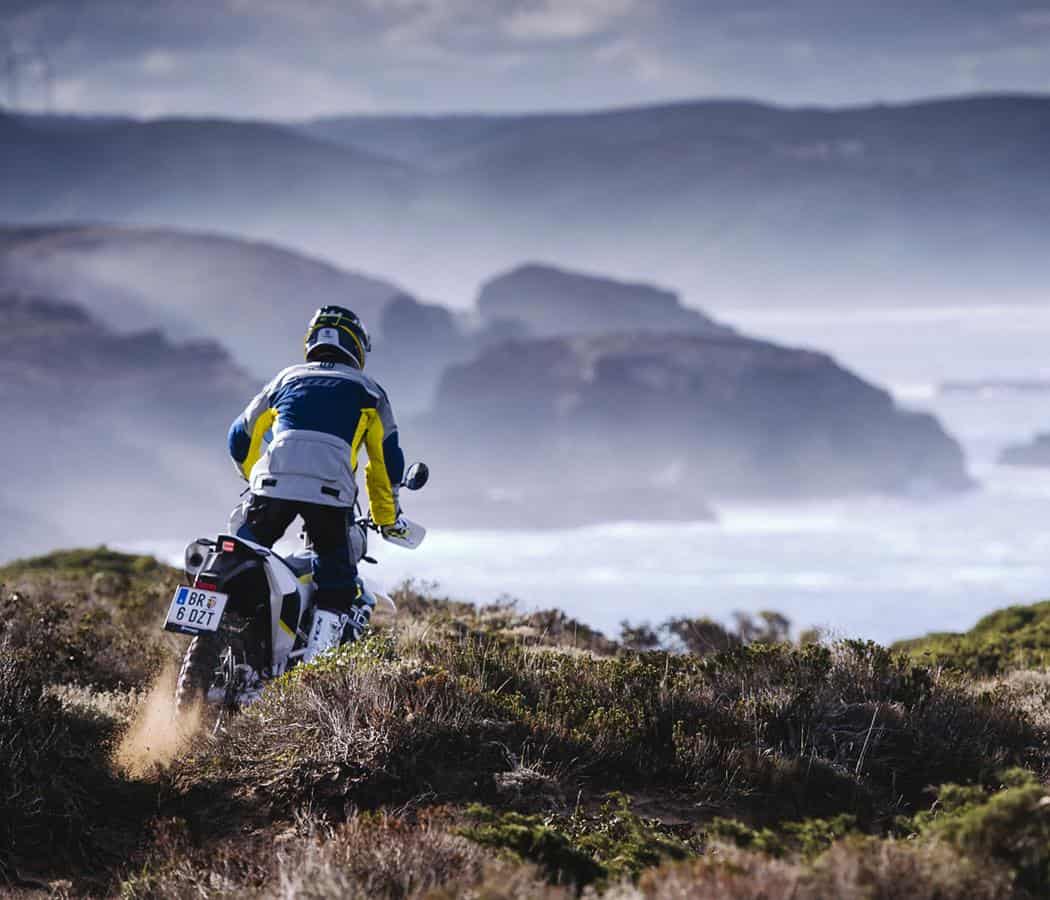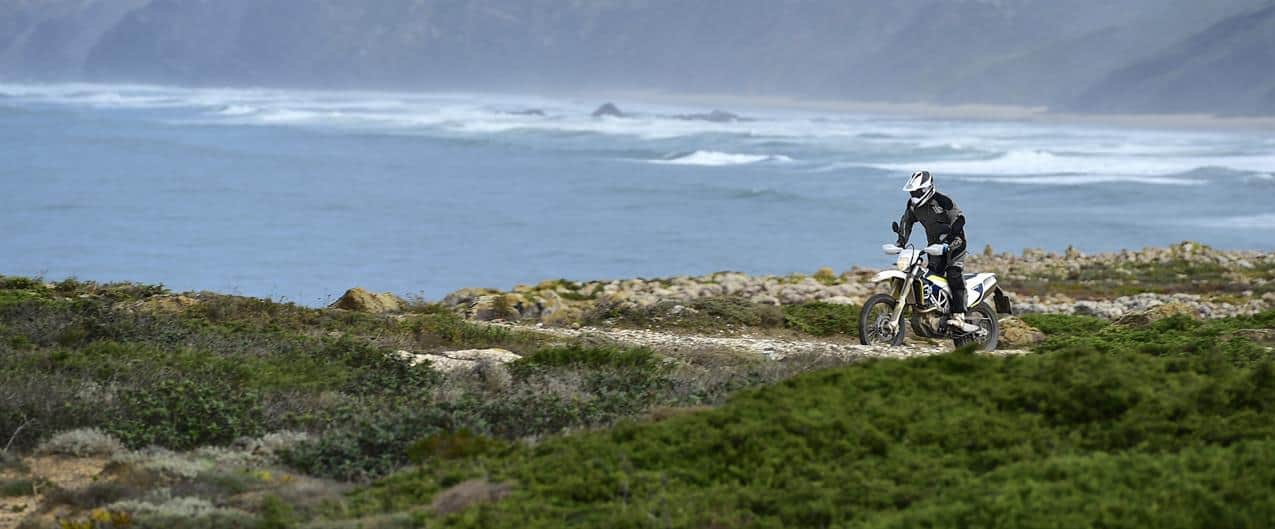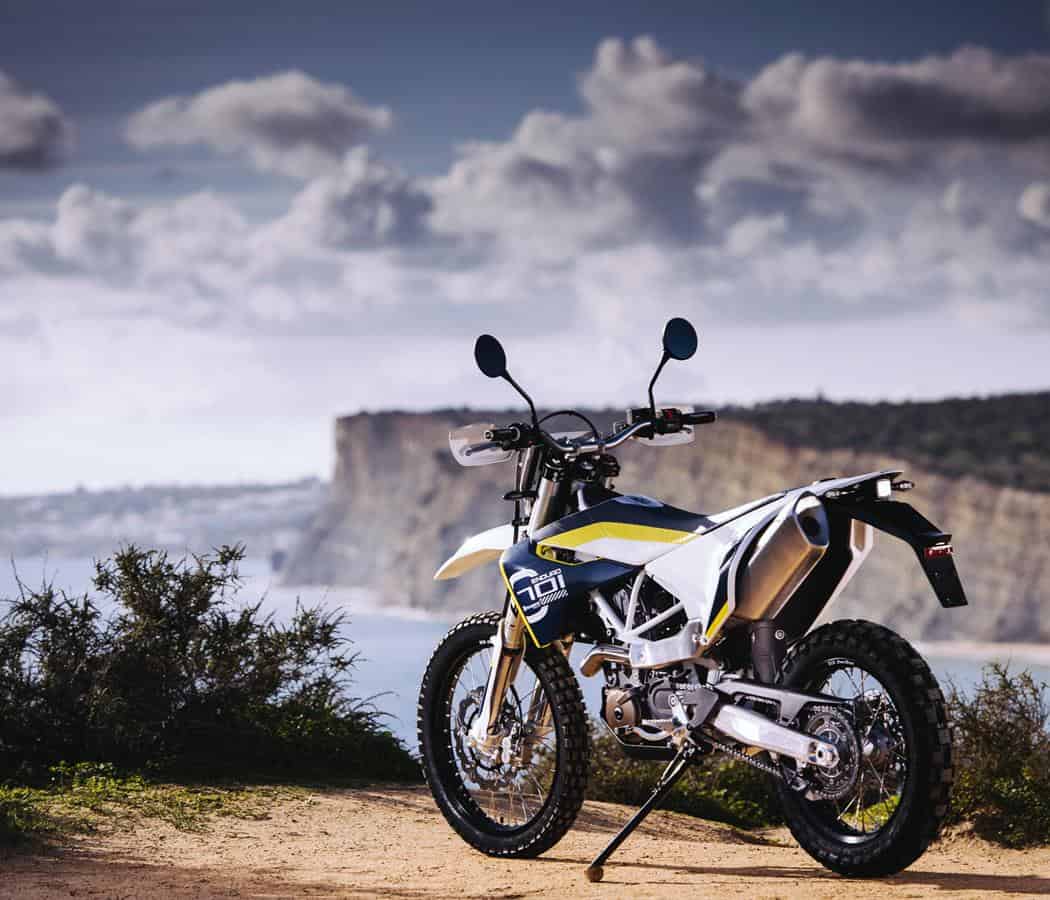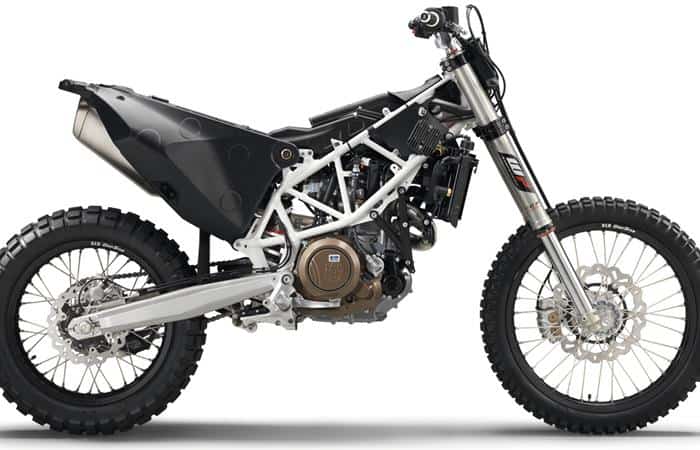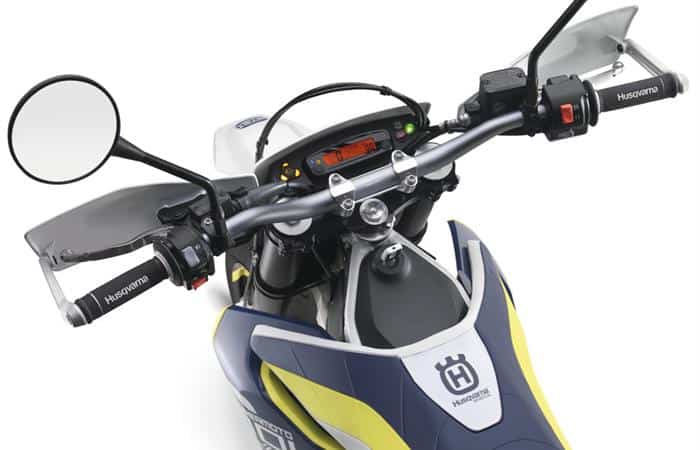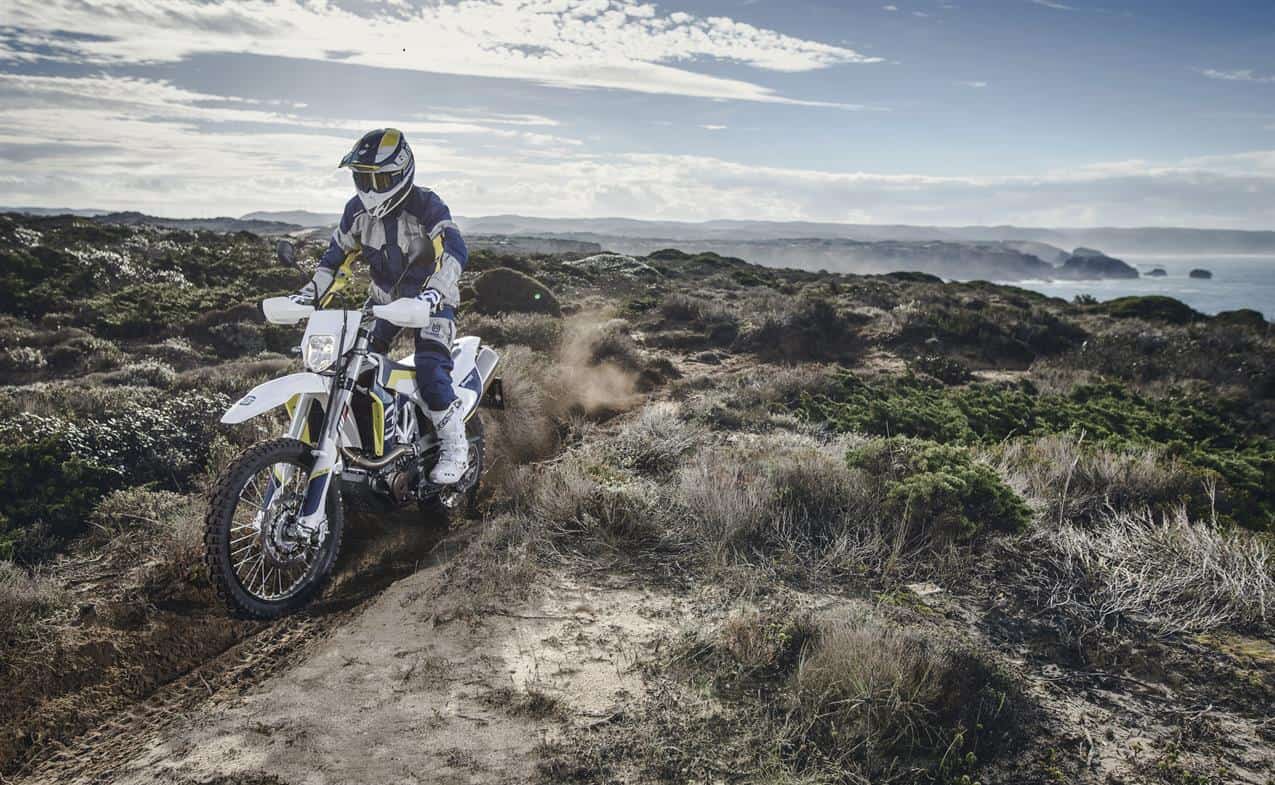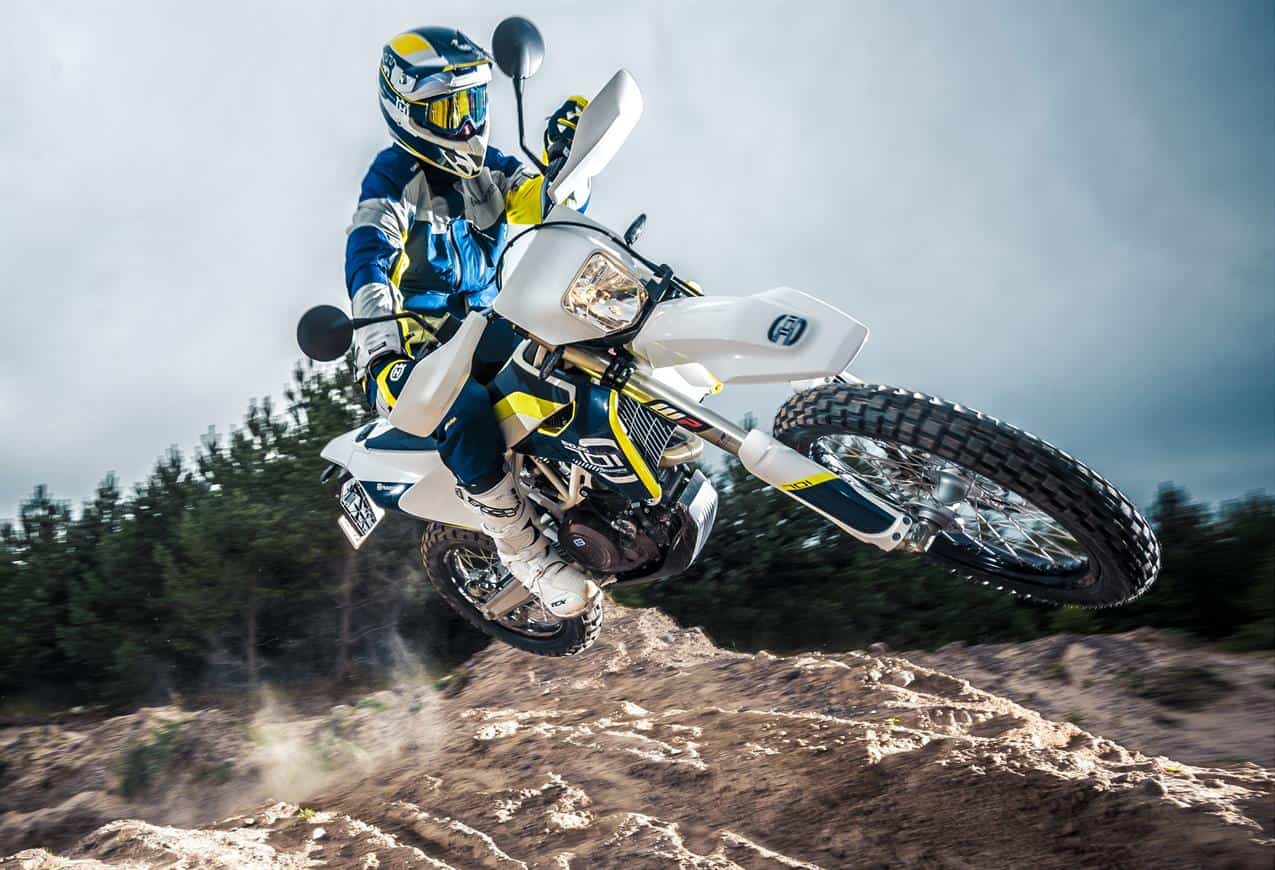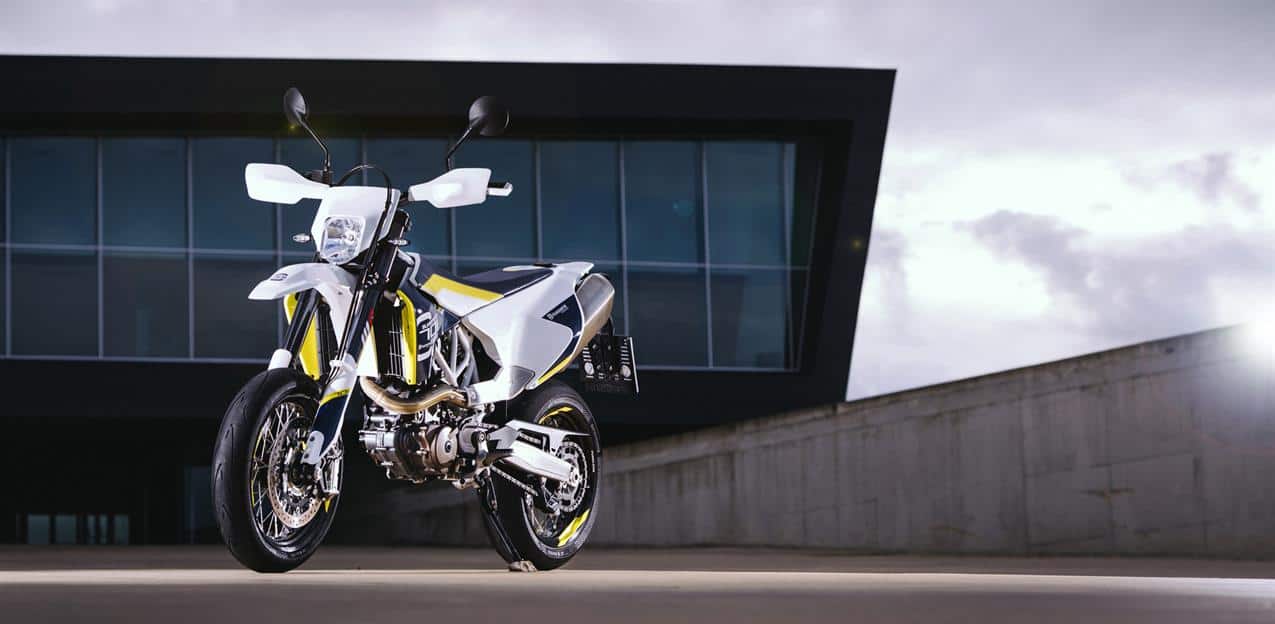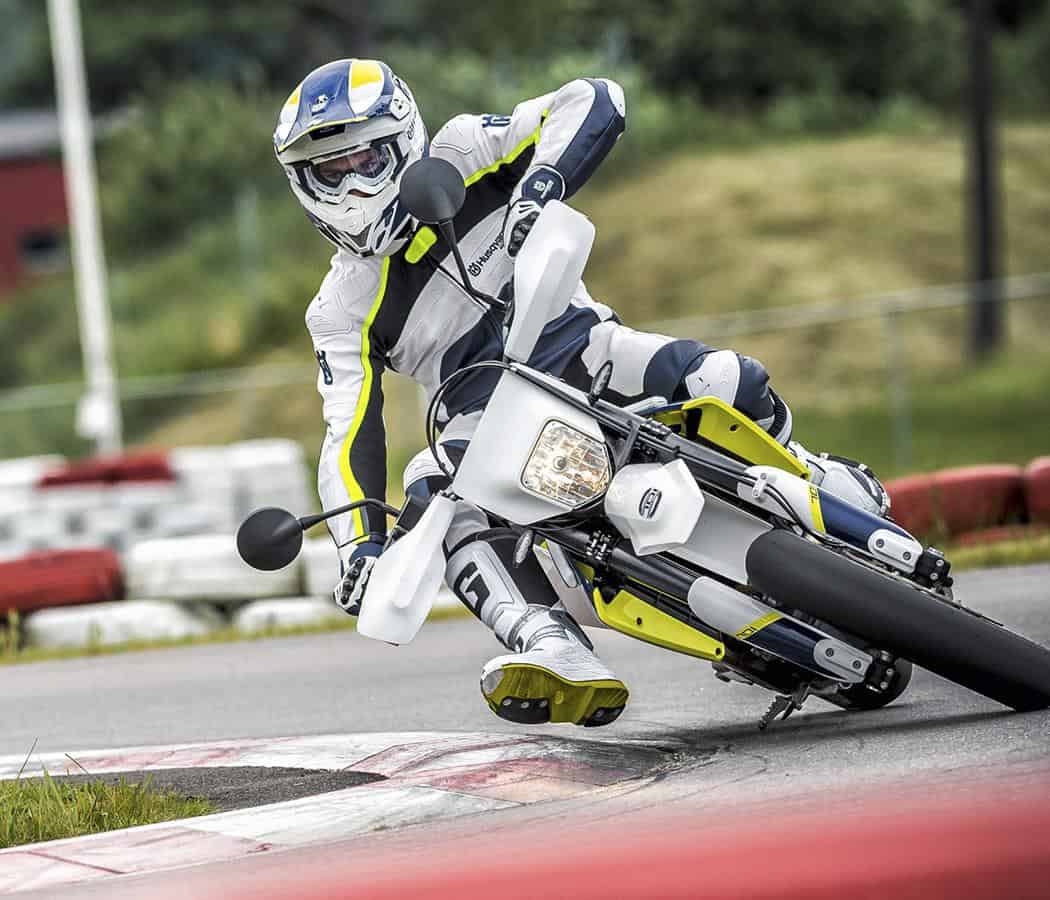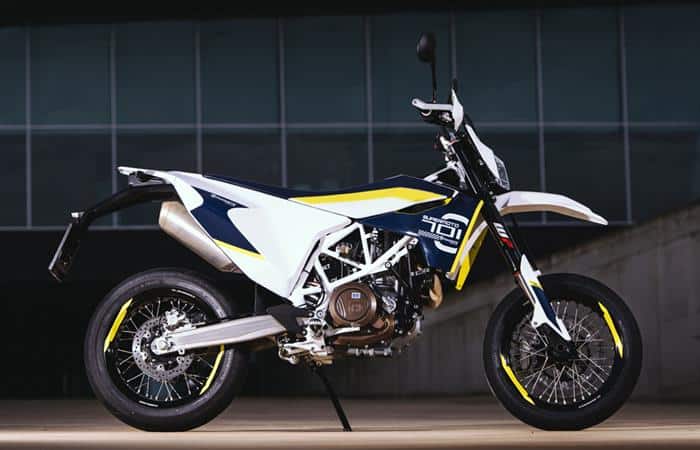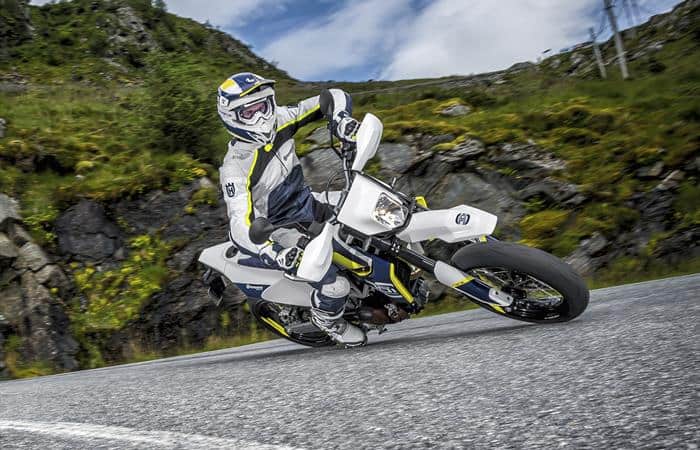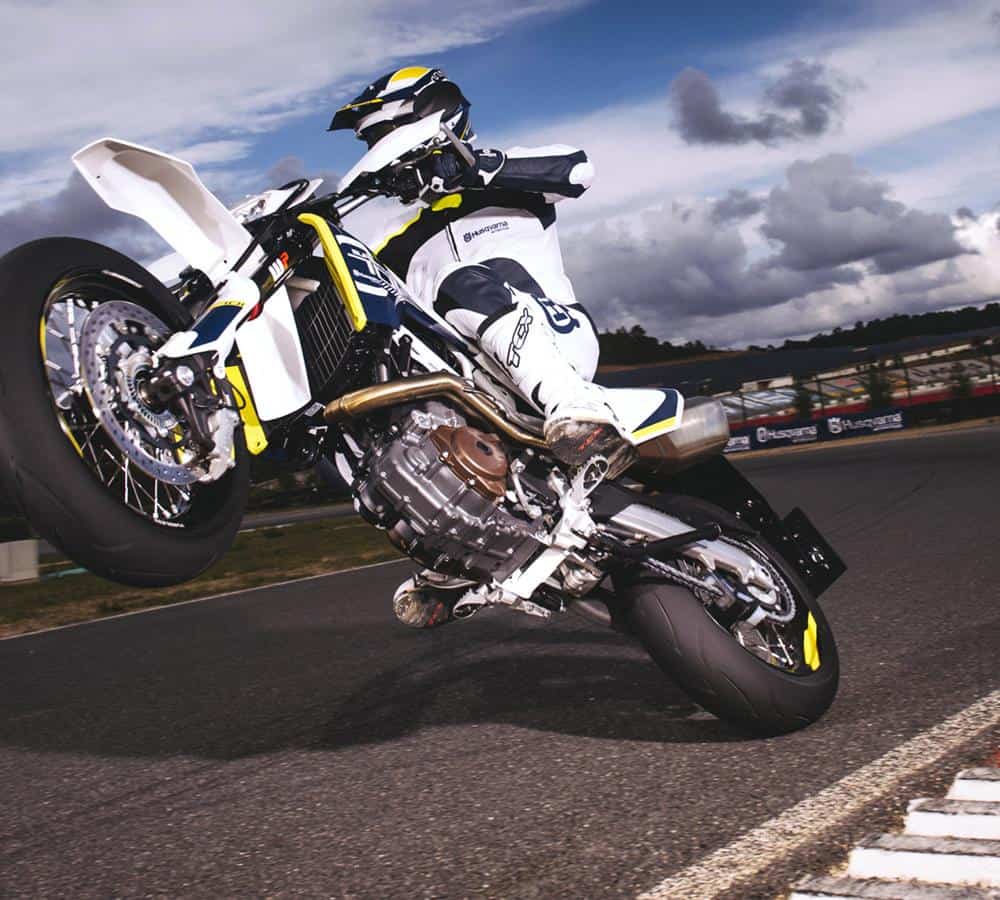The Husqvarna 701 Enduro/SM, two brand new machines in the Husqvarna line-up, but are they really what they seem?
It’s the smell you notice first… The sweet scent of Medronho hangs heavy in the morning air in this part of Portugal. This is Lagos, not the infamous Nigerian capital but a small holiday town perched right on the southern tip of the Iberian peninsula. Battered by the Westerlies that scud in from the North Atlantic, the burly Medronho plant hunches close to the ground to protect its crop of bright red spiky berries from the heavy showers that in wintertime lay waste to these normally arid lands. The fruit tastes a little like strawberries: more perfumed perhaps and with a characteristic crunch. The locals use it to make a potent clear liqueur that warms up the coldest of winter days.
But today isn’t cold even if it is decidedly wet at times. Perfect weather perhaps for testing the new Husqvarna 701s – two brand new machines in the Husqvarna firmament and blood brothers of the well-established KTM 690R, though sufficiently different for Husky to claim them as new models. I agree. More significantly perhaps, Husqvarna are hailing them as the first of a whole raft of new street bikes that will bear the famous crown logo. Right now Husqvarna may be KTM’s scrawnier brother, but Husky is filling out nicely and developing muscles in all the right places. Like all great sibling rivalries, I foresee the day when the cheeky upstart usurps his more powerful relative and takes over the role of breadwinner. But that day is in the future. Today is all about the 701s.
So a 701 Enduro and a 701 Supermoto. Forget the names, they are a misnomer. The Enduro is more sport-trail middleweight Adventure bike with genuine off-road credentials; the Supermoto more practical city sportster with a nod toward the hooligan. Both are rather better than you would imagine from reading their specs. Both sufficiently different from the 690 that spawned them. This is Husqvarna developing maturity which – it could be argued, for the second oldest motorcycle manufacturer still in continuous production – might have been slightly late arriving.
Like all cross-platform machines built in Mattighoffen in Austria, the Husky 701 and KTM 690 share the same underlying engineering and basic platform. The difference lies in the way the brands interpret their market positioning. I had expected Husqvarna to be sold as the premium brand – much as the parent company did with Husaberg – but chatting with the product manager at the launch, this friendly South African informed me that they were steadily positioning Husqvarna as the meat course on the braii, with KTM providing the spicy accompaniments. My words… not his.
When you look at this from a business perspective it would seem to make perfect sense. Husqvarna has the history, the name and the better brand awareness around the globe, so why not make the product with the broadest appeal a Husqvarna, and leave KTM to the purists? How this translates in terms of machinery can perhaps best be summed up by the difference in suspension between the two brands. You probably already know that Husky use a slightly different version of WP suspension compared with KTM (4CS forks and a rear linkage in this case), well the Husky 701 has 275mm of suspension travel whilst the KTM 690 EnduroR sports 250mm (an extra inch of travel in the Husky’s case). That makes the Husky plusher and slightly more compliant – more in keeping with its all-round appeal. The KTM by contrast uses a firmer set-up, more broadly in line with its ‘ready to race’ ethos.
And naturally enough, the differences don’t end there. Husqvarna always like to give their bikes a better fuel range (compared with KTM), so the 701 houses an extra 1.4 litres of fuel in its under-seat tank (built into the composite rear subframe), whilst subtle ignition mods should eke this out further still. Better than that however, Husqvarna also revealed that additional front lower tanks (one on either side – for their in-house aftermarket range) are in development, along with a large clear polycarbonate screen. So maybe the 690 Adventure we’ve all been craving for the past few years will turn out to be a 701 Adventure after all.
The other changes are designed to make the Husky look and feel different from its orange stablemate. So the white and blue bodywork with its distinctively long, flat seat also help differentiate the products. Interestingly Husqvarna say that the bodywork and seating position have been specifically designed to give the rider the feeling of sitting ‘in’ rather than ‘on’ the machine but I note that it’s still easy to slide up and down the seat for better body positioning in the corners. This is an important element of riding control, and Husqvarna are right not
to surrender it to comfort. Nevertheless the seat is genuinely very comfortable – as it should be for this kind of distance machine. It’s firmer on the Supermoto of course, but still extremely comfortable. Comfort may seem like a minor point in the overall
dynamics of this kind of machinery, but let me tell you it’s a subject that owners (as opposed to testers), always care about.
Compared with the 690R, the 701 feels slightly more user-friendly in my opinion – marginally softer all round I guess. It still has that slightly strange feel to the front end (accentuated on the KTM with its shorter forks), which at first makes it feel just a little unconventional compared with a normal trailbike, but once you get used to the way the bike turns, you quickly forget about it. Thereafter it’s simply pleasant riding all the way.
Despite Husqvarna claiming the 701 has plenty of low-down torque, it’s not exactly blessed with a booming bottom end. In fact it’s exactly as I remember the 690 – lacking stomp right off the bottom which seems strange for a big capacity single like this. No matter… the bottom end it possesses is more than sufficient, and with the 701 it’s all about the midrange anyway. This is a bike which enjoys eating up the miles whether they be on tarmac or tracks.
With that big piston hammering up and down the barrel you’d be forgiven for thinking the KTM would be quite vibey, but it really isn’t. There’s a counter-balancer working away to eliminate the worst of the vibes and KTM have done their homework in terms of taming any harshness, so that all that’s really left is a pleasant-soundingsingle-cylinder drone and sufficient ‘plonk’ underneath you to remind you that this is still a dirt bike at heart.
And as a dirt bike the 701 works a treat. It’ll handle anything from fast cruising stony tracks to slow-speed rocky steps (and all that on the stock dual-sport rubber), but I imagine it’ll become much more of a handful once there’s mud involved. I can’t say for certain, the tracks we rode were mostly dusty with puddles (a strange combo that’s for sure), and it never felt anything less than completely sure-footed at all times. Of course like any heavy(ish) trailie it shoves a bit more weight on to the front end, so you have to be more cautious before you go plunging into soft terrain, but it’ll cope okay, so long as you have your wits about you.
Husqvarna have sensibly resisted the urge to make this machine an out-and-out dirtbike. Whilst it’s not in any way wide, it’s still broader than a pure off-roader, and the size, weight and ground clearance – though doubtless class-leading for a trailbike – are one-step removed from your typical enduro bike. That makes it as good on tarmac as it is off it, although what it won’t do – at least not in the traditional way – is to break traction and power slide around all the loose-surface corners.
This chassis appears to have been designed to keep both wheels in line. If you want to get loose with it then you’ll need to be pretty brutal with the fly-by-wire throttle, and throw your weight around too; otherwise it just goes where it’s pointed. On the flip side of course it does mean that the 701 is super easy to ride – it rarely puts a foot wrong and instills a lot of confidence in the rider as you never find yourself fighting the power output.
Actually I think Husky have got the handling/power balance just right because the 701 is deceptively fast when you need it to be thanks to the fact that it hooks up and drives everywhere. The lengthy wheelbase no doubt helps, and actually I think most riders will find this pronounced stability a real asset. Certainly when it comes to riding in poor weather (and we rode in plenty of that), on iffy roads (likewise), the Husky never once put a foot wrong. At first I was slightly miffed that big handfuls of throttle didn’t instantly translate into big long drifts on the stony corners, but I understand why they’ve clipped this bike’s wings – It’s an adventure bike first and foremost, more than it is a pure dirt bike. Husky may disagree with me on that, but I think there are more people out there willing to invest in a fine handling, well-suspended, go-anywhere adventure bike, than those who just fancy the idea of a really big-bore dirt bike.
And certainly the suspension, brakes and the rest of the package seemed tuned in to this ideal. The suspension was superb, plush but easily capable of taking the hits you get with a bike of this weight and speed. With a hand-adjustable compression damping clicker at the top of one fork leg and a rebound damping clicker set atop the other, the Husky’s forks require no tools to adjust them. At the rear there’s a WP shock that’s also fully adjustable, working through a linkage set-up. I had no issues with either end which is just what you’d expect of a high quality WP set-up. This is way better than the kind of suspension you find on other (lesser) trail bikes. More serious, more capable, more reliable, and ultimately more than enough for this kind of bike. It is certainly well specified.
The brakes are interesting though. EU rules dictate that from 2016 (I believe) all road-legal machines must be fitted with ABS. This poses a few problems for dual sport bikes like the 701E. On the Husky you can switch between full ABS, partial ABS (front only), and no ABS. It works a treat and mostly we rode in the partial ABS mode. Most of the time you don’t notice it, and on the road if you do manage to actuate the ABS, you’re very thankful for it. The brakes offer a decent compromise between being too powerful for the dirt and lacking enough bite on the road. It’s a tricky one to juggle but Husky have managed it I reckon. If I had a complaint, it’s only that the rear sensor wire looks vulnerable to getting snagged, located where it is.
Other stuff….? Well the Husky feels very civilised and quite grown up if you know what I mean. It’s definitely aimed at the road riders out there. It’s quiet and comfortable and extremely well appointed. This is a good thing by the way, I’m all for bikes which don’t tire you out through noise and vibration, especially when there’s a long ride ahead.
At £7995, it remains to be seen how many will find owners in the UK. The road bike market is extremely competitive right now with the likes of Yamaha’s superb little 689cc MT07 (among others) offering superb value for money in the middleweight sector. They might not have the Husky’s go-anywhere versatility, but the modern style of urban roadbike often apes the trail style anyway; with long travel suspension offering good visibility and a pot-hole friendly ride, not to mention, a comfy riding position and good all-weather attributes. And here’s the thing… the MT07 retails for just £5600, and for that you get the benefit of a twin cylinder engine with slightly superior performance.I realise they’re not quite the same thing, and don’t really occupy the same ground, but owners in search of new wheels tend to consider all alternatives – especially where the price differential is as great as that.
I really like the 701 Enduro but to my mind it would be even better if Husqvarna were to offer it with the screen and front tanks thrown in for the same price. That way it would at least offer a greater degree of versatility to those that wanted to travel further afield, and it would go some of the way towards justifying its high-end pricing. It’s a good bike for sure but not an exceptional one, and at £8k it really needs to be exceptional for a single.
Supermoto
Strangely enough I think the Supermoto version of the 701 actually has far more appeal from an owner’s perspective. That’s because living in London as I do, I can actually see the benefit of the 701SM as a practical cross-town commuter, and all round urban machine.
I don’t want to give the impression that the 701 SM is in some way soft or bland, or even a bike out of time – it’s none of these things. We rode it on a very damp kart track (as well as on the street) and it does a fine job of handling the tight corners and stumpy little straights, with great brakes, awesome ground clearance through the corners and a punchy motor. As the former publisher of Supermoto Magazine I’ve ridden enough motards in my life to know that the 701 is not simply trying to act the part.
No, my problem with the 701, is not really with the bike at all – it’s actually a fine handling, great looking naked bike. My problem is with the name… Supermoto (as a road bike term) conjures up all sorts of horror stories in the minds of riders – overly firm suspension, noisy pipe, stupidly short gearing, horrible vibes, Christmas cracker switchgear, wooden seat, comfort measured in minutes – when really the Husky isn’t like that at all.
Try to banish all thoughts of the previous Supermoto craze out of your head for a moment because this bike is not the same as those old-school motards that the factories produced 10-12 years ago. For a start it’s way more civilised than they ever were: smoother, less single-minded, better designed and constructed, and frankly a much better all-round road bike. Think about it… it has a longer, more stable chassis, better range, a much greater degree of comfort and finish, and a much more relaxing and flexible engine than those headbangers of old. It’s in no way boring either, in fact I reckon it’s the direction that street-going SM bikes should have been developed in order to secure their future. Husqvarna’s problem is gonna’ be in convincing a bike-buying public that is rightly sceptical of purchasing a style of machine that’s had its day and is too recent in the memory to evoke any kind of nostalgia.
In that sense Husky might have done better renaming it as some kind of urban/naked/city concept, or even just given it a cool name, because really the SM moniker is doing it no favours at all. That’s a shame because it really is an excellent city bike. It’s comfortable, easy to ride, smooth and powerful without feeling anodyne. In fact I really enjoyed the SM; the chassis works brilliantly, the semi-slick fat tyres grasp at the tarmac with real voracity and offer a level of feedback through shortie WP suspension that very few pure street bikes can match. And the handling is sublime – not in the least bit twitchy at high speeds, yet quick enough to make it a real hooligan tool when you want it to be. The engine too feels just brilliant – its not cobby or lumpy, or crude or short-geared, yet it retains real single-cylinder character and punches the bike out of turns, like only a single cylinder machine can.
The riding position is spot on as well. It’s not as cramped as a traditional dirtbike-based SM, nor quite as upright, and there’s plenty of room on that long seat for a friend to accompany you across town. The 701 SM is probably good for 120-odd mph, but you don’t need me to tell you that anything over 100mph feels like you’re riding into the teeth of a hurricane. I’d love to have seen Husqvarna equip it with a small semi-circular, retro-style cafe-racer screen to be honest, and maybe some slightly more retro-style bodywork… that would have at least distanced it from the dated SM look, and given it a style of its own.
The problem is that KTM already produce a crazy-ass street-SM based on this bike’s architecture (the 690SMC), and they have the pure street bike version well covered with the 690 Duke, leaving nowhere for the 701 Supermoto to go. At least if they’d given it single-cylinder café racer style looks or made it more akin to a Ducati or Triumph Scrambler then they could have aimed it at the beardonistas. Which would have picked up on the zeitgeist if nothing else.
So…. great bike with great brakes and handling, a wonderful one-lunger motor and a really, really easy bike to ride around town. But the high price and (I think) the packaging count against it. Especially considering that Triumph’s new retro-styled 900cc Bonneville Street Twin that launches early in 2016 will undercut it on price.
I genuinely liked liked riding both of these bikes but it’s not enough to simply deem them great to ride when their pricing point takes them up into territory occupied by far more upmarket machinery.
If Husqvarna are serious about busting into the road bike market then let’s see them break new ground in terms of fresh design, or at least be creative with their pricing and marketing. These bikes deserve a wider audience than they’ll get at this price and really Husqvarna ought to have known that. Good bikes… Just not at that price.
Husqvarna 701 Enduro/SM
Price: £7999 (At the time of going to press)
Engine: Single cylinder, 4-valve, SOHC, 4-stroke
Capacity/fuel system: 690cc / Keihin EFI 46mm
Bore & stroke: 102 x 84.5mm
Power (claimed): 67hp @ 7500rpm
Transmission: 6-speed
Frame: Chrome-moly steel-trellis
Front susp/travel: 48mm WP USD / 275mm (215mm)
Rear susp/travel: WP mono with link / 275mm (250mm)
Front brake: Brembo 2-piston, 300mm (4-piston, 320mm)
Wheel size F/R: 21/18in (17/17in)
Seat height: 910mm (890mm)
Fuel Cap: 13Litres
Dry weight: 145kg (145kg)
Contact: www.husqvarna-motorcycles.com

